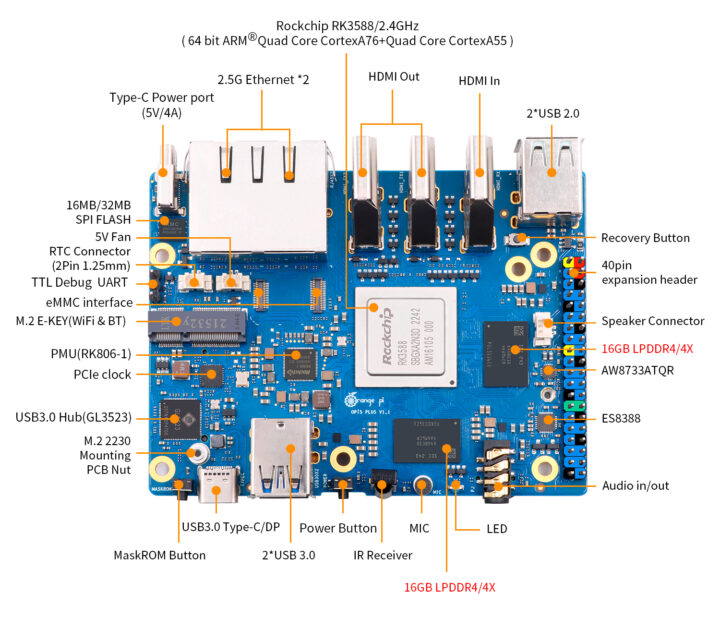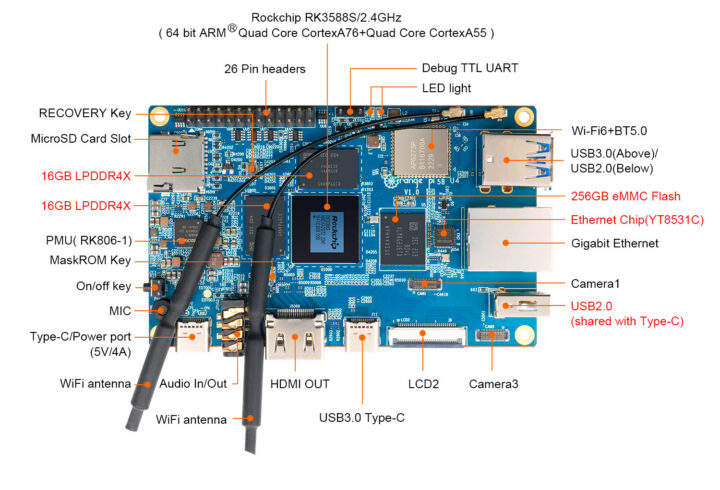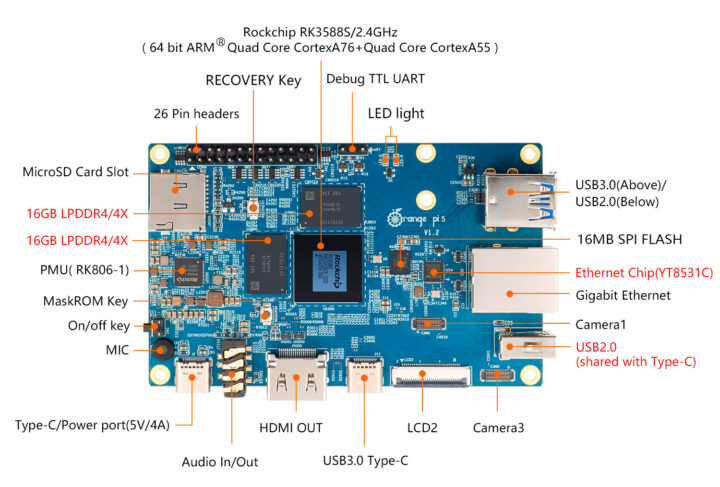Rockchip RK3588 SoC has long been advertised as supporting up to 32GB RAM, but the higher RAM capacity was mostly vaporware until Firefly introduced versions of their RK3588 boards and modules with 32GB RAM at the beginning of the summer.
Orange Pi has now unveiled its own 32GB RAM versions of the Orange Pi 5, Orange Pi 5B, and Orange Pi 5 Plus single board computers powered by the Rockchip RK3588S or RK3588 octa-core Cortex- A76/A55 SoC.

Besides the higher RAM capacity, nothing else has changed and for reference, here are the Orange Pi 5 Plus 32GB specifications:
Orange Pi 5 Plus specifications:
- SoC – Rockchip RK3588
- CPU – Octa-core processor with 4x Cortex-A76 cores @ up to 2.4 GHz, 4x Cortex-A55 cores @ up to 1.8 GHz
- Arm Mali-G610 MP4 GPU with support for OpenGL ES1.1/2.0/3.2, OpenCL 2.2, and Vulkan 1.2
- 6 TOPS AI accelerator with support for INT4/INT8/INT16/FP16 mixed operation
- VPU – 8Kp60 H.265/VP9/AVS2 10-bit decoder, 8Kp30 H.264 decoder, 4Kp60 AV1 decoder, 8Kp30 H.265/H.264 encoder
- System Memory – 32GB LPDDR4/4x
- Storage
- 16MB or 32MB QSPI NOR Flash
- MicroSD card slot
- eMMC flash socket for 32GB, 64GB, 128GB, or 256GB module
- M.2 2280 PCIe 3.0 x4 socket for NVMe SSDs up to 2,000 MB/s
- Video Output
- 2x HDMI 2.1 ports up to 8Kp60
- DisplayPort 1.4 up to 8Kp30 via USB-C port
- 2x 4-lane MIPI DSI connector up to 4Kp60
- 6-pin FPC socket for touchscreen
- Video Input
- Camera I/F – 4-lane MIPI CSI connector
- HDMI 2.0 input up to 4Kp60
- Audio
- ES8388 audio codec, AWINIC AW8733ATQR audio amplifier
- 3.5mm audio jack with headphone and microphone support
- Onboard MIC
- Support for HDMI 2.1 eARC
- Speaker connector
- Networking
- 2x 2.5GbE RJ45 ports via RTL8125BG controllers
- Optional WiFi and Bluetooth via M.2 module
- USB – 2x USB 3.0 ports, 1x USB 3.1 Gen 1 (5 Gbps) Type-C port, 2x USB 2.0 ports
- Expansion
- 40-pin header with GPIO, UART, I2C, SPI, CAN, I2S, PDM, AUDDSM, SDIO, PWM
- M.2 Key-M socket (PCIe 3.0 x4) for 2280 NVMe SSDs, or other PCIe 2280 modules (e.g. AI accelerators)
- M.2 Key-E socket (PCIe 2.0 x1/PCM/UART/USB2.0) for 2230 modules such as WiFi 6 and Bluetooth modules
- Debugging – 3-pin UART header for serial console
- Misc
- Power, MaskROM, and Recovery buttons
- Power LED, status LED, RGB LED
- IR receiver
- 5V fan connector
- 2-pin connector for RTC backup battery
- Power Supply
- 5V/4A via USB Type-C port
- RK806-1 PMU
- Dimensions – 100 x 70 mm (Slightly wider than Orange Pi 5B)
- Weight – 86.5 grams

32GB RAM on Rockchip RK3588 used to be prohibitively expensive explaining why manufacturers would not initially offer this option, but it has come down in price quite a lot with Orange Pi offering the following pricing:
- $159 for Orange Pi 5 with 32GB RAM on Aliexpress or Amazon
- $179 for Orange Pi 5B with 32GB RAM and 256GB eMMC flash on Aliexpress or Amazon
- $179 for Orange Pi 5 Plus with 32GB RAM on Aliexpress or Amazon
Note those are pre-orders with shipping scheduled to start by October 31 and shipping is not included. The boards are a bit more expensive on Amazon due to the extra/higher fees. The biggest competitors to the RK3588 boards with 32GB RAM may be the Intel Processor N100 mini PCs or motherboards which look to support 32GB RAM even though the CPU is only advertised up to 16GB on Intel Ark. That’s unless you need some specific features such as GPIOs, HDMI input, LCD and/or MIPI CSI camera interfaces.


Jean-Luc started CNX Software in 2010 as a part-time endeavor, before quitting his job as a software engineering manager, and starting to write daily news, and reviews full time later in 2011.
Support CNX Software! Donate via cryptocurrencies, become a Patron on Patreon, or purchase goods on Amazon or Aliexpress. We also use affiliate links in articles to earn commissions if you make a purchase after clicking on those links.




Nice there’s some movement on this front!
Wondering why there are no boards taking advantage of the (~30%) extra bandwidth LPDDR5 would provide. Is DDR5 that much more rare/expensive or is it just not working as well as it should on the RK3588?
Sometimes the reason why nobody adopts an expectedly better option is simply that it doesn’t work as expected. It’s possible the RAM controller experiences failures with LPDDR5 or that it heats a lot and forces thermal throttling or any such thing. It’s hard to know. We’ll see over time if the situation evolves.
How does it fare against lower RAM’d versions?
It depends on the application. If you are typically using less than 16GB RAM, then there won’t be any difference, but if swapping occurs often, then switching to 32GB RAM should lead to a big boost in performance and/or a more stable system.
The board looks appealing but I can’t remove from my head that more and more N100-based devices are available at high frequencies and very low prices with enclosure, standard BIOS etc. I suspect that the availability of the N100 will hurt a little bit the ARM SBC market now that prices have increased and there are less savings to be made by investing effort porting to such boards.
Seconded. For ~$130, we could get N100 mini-pc complete with case, psu, 16GB RAM and 512GB SSD, wifi+bt. And their close contender, OPI5B+ is priced $129 without case, psu, storage, wifi+bt.
I certainly will go for x86 if I won’t have to use the GPIO and/or 2.5Gb LAN, or have it just for fun.
Anyway N100 should consume more than RK3588 and also will make more heat.
For example at the moment my passive cooled RockPi 5B takes in average 6W and is usable in full load mode, but N5105 passive cooled Topton G31 eats ~16W on low load, but in full load mode it overheats 🙁
N100 will provide more power, but IMHO heating will be close to N5105 levels despite to declared 6W TDP – pls. correct me, if I’m wrong.
Most people looking for a cheap desktop aren’t going to care about the extra power consumption, I/O differences, etc. Just that Intel’s x86 offering runs OS/software as expected and is in the same performance weight class for a similar price.
I don’t think the RK3588 outperforms the Alder Lake-N quad-cores even in multi-threading. If 8-core N300/N305 systems were available at the magic $150 price point it would truly be over. Not sure about the graphics (models with 16, 24, and 32 EUs are available).
Have we seen recent Rockchip roadmaps @Jean-Luc? IIRC RK3588 will be the lead offering for a long time, while Intel could refresh its lineup with Crestmont or Skymont E-cores within the next few years (after a “Twin Lake” with Gracemont again). If that’s the case, the situation could get worse and Intel could use node shrinks to its advantage.
The offerings with P-cores would be even better if Intel were to dump them onto the market at low prices (although there’s no evidence that they will). Meteor Lake is rumored have a new 1P + 8E configuration (compared to 1+4 or 2+4 made with 2+8 dies in the previous gens). Meteor Lake should also have a dedicated AI accelerator, which is not found in Alder Lake-N but present in RK3588.
BTW, Frore AirJet can’t come fast (and cheap) enough for cooling.
Actually, RK3588 have similar multi-thread perf vs N100 and lost in single-thread vs N100 (geekbench). But from the price point, I’d rather go with N100. As it’s cheaper and you can get in complete packages vs RK3588 SBC.
Most cheap desktop users are stubbornly looking for windows out of the box, so RK3588, especially with 32GB RAM, seems more suited for homelab server at the moment. I saw post in Armbian forum that somebody already managed to launch Proxmox on RK3588.
Sure, such board also is perfect for Linux desktop – although some time ago driver part seemed too raw to be used in such way.
I haven’t seen a Rockchip roadmap for a while.
One of the new chips expected soon is the Rockchip RK3582 with just two Cortex-A76 cores, an unspecified number of Cortex-A55 cores, and designed for TV boxes.
You can see a board @ https://twitter.com/remetooldd/status/1711222824529268980
But I haven’t been able to write anything about it so far due to the lack of information.
For your average Joe, 6W vs 22W is not that much. Plus the x86 one is more user friendly. Except if planning to use the OPI5+ for NAS, or server. But it’s not for your average Joe.
Average Joe often wants silent (passively cooled) PC – in this regard each watt matters 😀
That’s not your average Joe. Average Joe’s content with functional PC.
I don’t think ANY average Joe should buy an arm sbc that is not a raspberry pi. Only the raspberry pi as an arm sbc could provide user-friendly enough software support for its users to use it as a functional PC. I don’t really think average joes affect the sales of rk3588 sbcs a lot because nobody would buy a piece of hardware that does not know how to use. Therefore, they will buy x86 alternatives or go with raspberry pis anyway.
Yes, exactly.
But they actually can use RK3588 SBCs, as long as their maker/seller provide android OS for them.
Probably for most people the N100 is a better choice because of the software support status, but the N100 comes with one quirk: its power consumption. For my use case like an encryption gateway, the RK3588 could easily do multi-gig vpn tunnel and easily cooled passively. If you are using an N100 under the same workload, you gonna need a fan or a super huge heatsink, and that makes me never think about the N100.
OK but for such use cases, the N5105 at 2.9 GHz is 50% faster than RK3588 at 2.4 GHz in my tests, and both are fanless. I, too, prefer ARM boards for fanless designs, but for my file server I finally decided on Odroid-H3 as it uses a standard kernel because I value my data. I’m using an ARM in my firewall (one with NAND!) but would happily switch to an x86 with as many ports and a block-device storage if it provided better value. That’s why I’m saying that things seem to be changing, when users like us who do not fear u-boot and USB-TTL adapters see less value in ARM-based SBCs these days. Take a “la frite” board from Libre Computer at $17 for a small device running mainline, it’s unbeatable. But here these boards are competing with PCs for more serious usage, they’re no longer embedded devices, thus they require better packaging, better recovery abilities (can you plug a screen, keyboard, USB thumb drive and boot off it ? I doubt it), and above all, support regular distros and kernels.
2×2.5gbps ports, but can the board even reliably push past 1gbps?!
If OPI5+ have same chip with RockPi5, then yes, The DL is close to 2.5Gbps, but UL is just ~1Gbps. https://www.youtube.com/watch?v=CxD_0q8tAdc&t=4s
I could get 2.5G wire speed in both direction by manually set the IRQ affinity to the A76 cores. The default settings it would IRQ on the A55 cores and then bottlenecks the nic.
I could get 30 Gbps using a 4x10G NIC plugged into a PCIe adapter on the Rock5B a year ago, so in terms of I/O there’s definitely quite some margin here.
Why not? Even much lower speced arm boards could saturate a 1G link…
All Orange Pi boards with 32GB RAM are sold out, and it’s unclear when they will be available again.
The Orange Pi 5 Plus with 32GB RAM is back in stock.